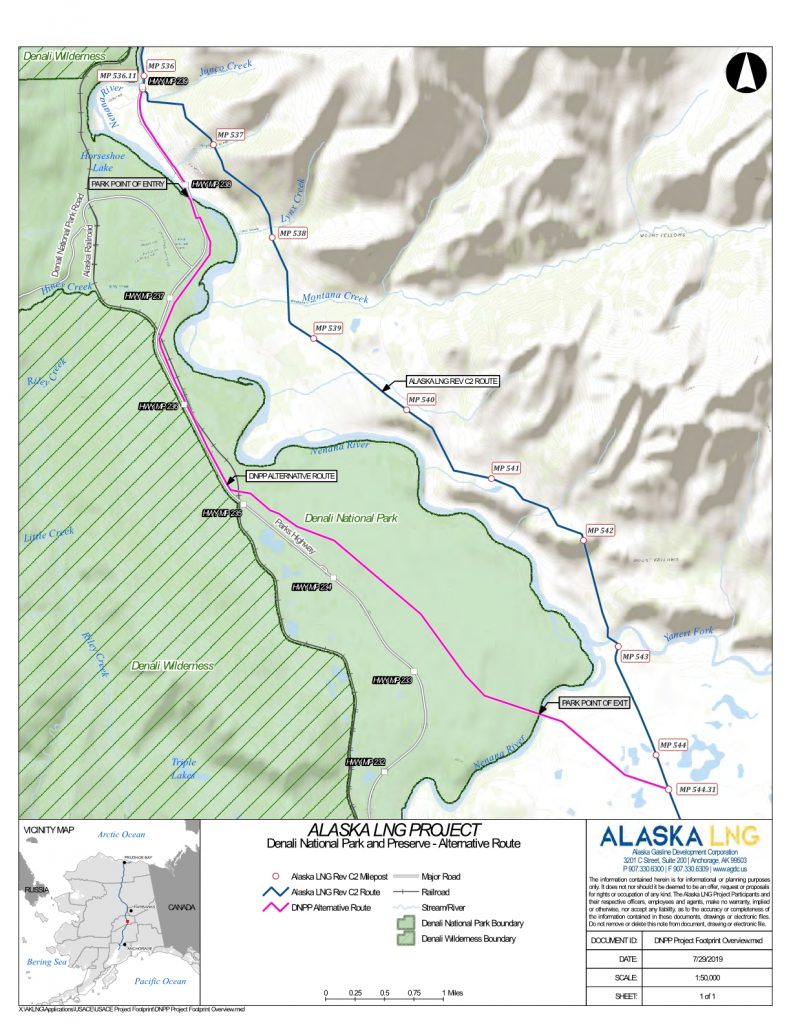Comment Now: Alaska LNG Pipeline EIS
The Federal Energy Regulatory Commission (FERC) has published a draft Environmental Impact Statement (EIS) for construction of the much-touted Alaska LNG gas pipeline project. Proposed by the Alaska Gasline Development Corporation, the project would include several components including an 800-mile, 42” diameter gas pipeline running from Prudhoe Bay to the Kenai Peninsula, a north slope gas treatment plant, and a gas liquefaction plant on the Kenai. The general concept is to build the infrastructure to pump natural gas from Alaska’s oil fields on the North Slope to a facility where it can be liquified and shipped abroad, while taking some off to use locally in Alaska. Public comments are due by October 3, 2019.
It has been a busy paperwork year for the increasingly unlikely gas pipeline. In February, Senator Lisa Murkowski got through Congress an amendment to the oddly-named 2013 “Denali Improvement Act” to further smooth the way for pipeline construction to occur inside the eastern boundary of Denali and avoid the rugged and scenic terrain across the Nenana River. In March, the U.S. Army Corp of Engineers and the Bureau of Land Management issued a record of decision for an EIS for the Alaska Stand-Alone Pipeline (ASAP) project, a smaller gas pipeline designed to serve in-state customers only but containing much of the same pipeline routing as the larger LNG project (although subsumed under the Alaska Gasline Development Corporation and largely replaced conceptually by the LNG project, the zombie ASAP continues to lurch forward not realizing it is dead). Finally, FERC released this Alaska LNG EIS at the end of June. It is a lot of paperwork for a project that does not have any money committed for pipeline construction, no producers who have committed to sell gas through it, and no buyers committed to purchasing the final product.
DCC’s concerns are focused on those elements that particularly pertain to Denali. The organization’s position has been that environmental impacts would be minimized by routing the pipeline along the Trans-Alaska Pipeline System corridor to Valdez rather than along a new corridor to the Kenai. FERC did consider this alternative, and their conclusion dismissing it from consideration is found in section 3.8.1.1 of the final EIS. FERC cites several reasons this alternative is less desirable, including the need for extra lengths of pipeline to serve in-state markets in Anchorage and Fairbanks, the fact that this pipeline could not fit alongside the Trans-Alaska Pipeline through Thompson Pass and thus would require a complicated additional route through the Chugach Mountains, extensive disturbance to the sea floor and hillsides in Valdez to construct the liquefaction and marine loading facilities, and ongoing disruption to regular boat traffic to provide buffers around LNG ships passing through the Valdez Narrows. DCC will be responding these objections in our comment.
Given the predilection of project proponents to build the pipeline to the Kenai, DCC has also been concerned about the routing it would take through the Denali Borough and near the national park boundary if constructed. Pipeline proponents have been concerned that placing the pipeline on national park lands would result in additional bureaucratic complications that could slow permitting. However, the ASAP pipeline EIS concluded that the “Denali NPP” route variation would be environmentally preferable, and Murkowski’s amendments should remove all bureaucratic obstacles. Nonetheless, as published this FERC EIS still proposes keeping the pipeline east of the Nenana River, crossing Montana Creek and the Yanert River. There are rumors that the Alaska Gasline Development Corporation would like to substitute the inside-Denali route variation during the public comment process, but that would be unusual and no official word has been received. The FERC EIS concludes that the two alternatives would be roughly equal in environmental impacts. The analysis can be read at 3.6.2.

If the pipeline is built down the George Parks Highway and takes the Denali Alternative route, it would avoid new disturbance and access to the Montana Creek area and portions of the Yanert Valley. However, it would still cross the Nenana River and cut across behind Karma Ridge to join the Intertie right-of-way, creating disruptions for those who live and recreate in the area, and would impact more businesses in the Canyon. The proposed route would have impacts elsewhere too, for instance where it leaves the Parks Highway corridor to cross open country west of Otto Lake. FERC expects to complete the Final EIS in early 2020, although that may be the least of the project’s hurdles as state support wanes and the market for the gas remains bleak. Members of the public can read the EIS and submit comments directly through the FERC website at https://www.ferc.gov/industries/gas/enviro/eis/2019/06-28-19-DEIS.asp by October 3. DCC has heard that FERC will host a local meeting at the Tri-Valley Community Center on Wednesday, September 11, 2019 from 5-8pm. Watch locally for further information.


